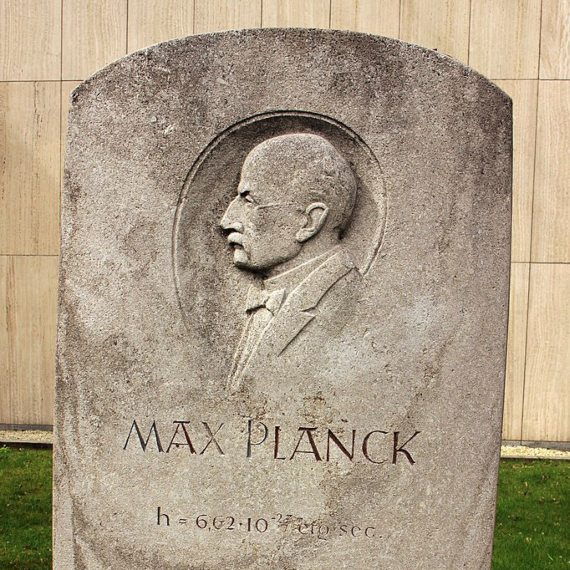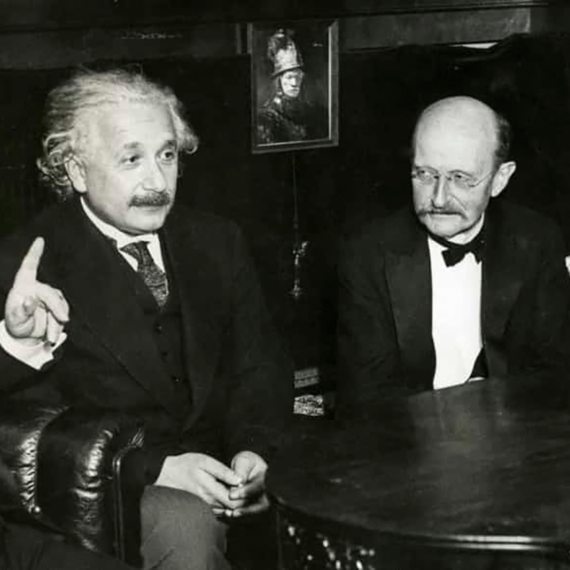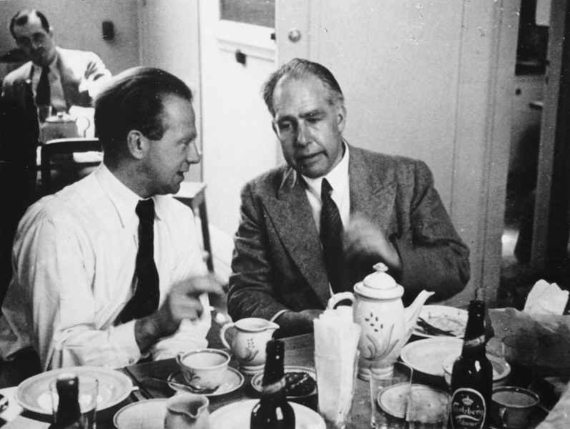Werner Heisenberg recalled his long discussions with Niels Bohr that lasted late into the night. In his 1958 book Physics and Philosophy: The Revolution in Modern Science, the physicist recounted how, after those conversations, he would often go for a walk in a nearby park and keep repeating to himself: “Can nature possibly be as absurd…?” Ever since Max Planck founded quantum theory on December 14, 1900, scientists have been perplexed by their own findings, none of which seem to make sense. Nothing is intuitive or reasonable, so much so that more than half a century later, Richard Feynman uttered one of the most famous sentences on the subject: “I think I can safely say that nobody understands quantum mechanics.” “Just relax and enjoy,” he advised those attending a conference at Cornell University in 1964.

Planck’s first paper solved a hitherto unsolvable problem. The physics of the late 19th century could not explain the pattern of light emission from a hot body. Planck decided to wipe the slate clean and start again, discovering that everything worked when he plugged a constant into his equations. The problem was the sheer absurdity of the implications, that energy could not have whatever value, but only multiples of that constant. This was as aberrant as thinking that a sandbag could only weigh one kilo or two, but no value in between. From today’s perspective, we now understand that between one electron and two electrons there is nothing in between. But at the time it was difficult to accept a theory that was equivalent to treating energy as matter, divided into discrete packages or “quanta.”
Even Planck himself resisted his discovery. He later confessed that he was simply trying to “obtain a positive result, under any circumstances and at whatever cost.” For years he tried to fit his constant into classical physics, but without success. And despite the absurdity of the idea, it turned out that data from other scientists fit quantum theory like Cinderella’s glass slipper.
Interactive timeline: 120 years of Quantum Physics
[+] Watch Fullscreen
Einstein and the “quanta of light”
One of the first to appreciate this discovery was Albert Einstein. In 1905 he wrote a paper in which he applied Planck’s theory to the photoelectric effect, a phenomenon described in 1887 by Heinrich Hertz by which light stripped electrons from metals. The classical electromagnetism of Hendrik Lorentz and James Clerk Maxwell did not explain why this only happened at certain wave frequencies. Einstein decided to look at light through the lens of Planck’s quanta; light did not behave like a continuous wave, but as a jet of particles, “quanta of light”—today’s photons—of discrete energy.

Interestingly, Planck rejected Einstein’s hypothesis. So did Robert Andrews Millikan, who set out to refute it experimentally at all costs… only to end up agreeing with it. More curiously still, Einstein himself also began to express scepticism about quantum theory when the work of other researchers led physics into a realm more like Alice’s Wonderland than anything known about the real world.
Niels Bohr was the first to apply quantum mechanics to describe the atom, and in 1913 he produced a model that was a radical departure from earlier ones. The atom that Bohr proposed, based on the previous model of Ernest Rutherford, emits or absorbs energy whenever an electron jumps between discrete circular orbits. The values allowed by Planck’s constant implied that the electron jumped from one orbit to another without passing through the intermediate places. Arnold Sommerfeld generalised Bohr’s model in 1915 by replacing the circular orbits with elliptical ones.
Copenhagen interpretation of quantum mechanics
In 1925, Heisenberg, his teacher Max Born and Pascual Jordan took the work of Bohr and Sommerfeld as a starting point to mathematically formulate quantum mechanics using matrix algebra. Wolfgang Pauli applied this matrix mechanism to Bohr’s atomic model, but the following year this approach was overtaken by the wave function proposed by Erwin Schrödinger. In this step, the contribution of Louis de Broglie was fundamental, which in a sense reversed the way to look at the quantum world: if light could behave like a particle, an electron could also behave like a wave. Later, Paul Dirac would merge Schrödinger’s equation with those of Heisenberg.

Schrödinger’s wave function described the state of a quantum system; however, while Newtonian mechanics made it possible to predict the position and speed of an object, as seems logical, Born’s interpretation of the wave equation turned the orbits of electrons into something very difficult to imagine: probability density clouds. This meant that an electron occupied its entire orbit at the same instant.
From this, Bohr and Heisenberg came up with the so-called “Copenhagen interpretation” of quantum mechanics, according to which this uncertainty disappeared when measurement was applied to a system; only then did the wave equation collapse and these superimposed states materialise into one position for a particle. The observer changed the system, which led Schrödinger to describe his famous thought experiment of the cat that is simultaneously alive and dead until the box is opened to check its state and break this duality. In Schrödinger’s equation, the position and velocity of a particle were like pulling on two ends of a blanket, so both could not be known precisely at the same time, something that was reflected in Heisenberg’s uncertainty principle.
Einstein-Podolsky-Rosen Paradox
All of which led Einstein to ask: does the Moon only exist when we look at it? With his general relativity, the German scientist had transcended the Newtonian view of gravity as a mysterious action at a distance and replaced it with a continuous fabric of space-time that conveyed this effect. And yet, according to quantum mechanics, the effect of the observer on one particle could be transmitted to another identical one, both separated at birth, instantaneously, which Einstein dubbed “spooky action at a distance.” While he did not doubt the theory, he believed it to be incomplete; he felt that hidden variables could explain the effect without having to resort to the probabilistic mechanism. God does not play dice, he wrote in a famous letter to Born.
This thought experiment of Einstein, today called the Einstein-Podolsky-Rosen Paradox, gave rise to the concept of quantum entanglement, the name by which this spooky action at a distance is known today. In 1964, John Stewart Bell was inspired by an alternative interpretation of quantum theory developed by David Bohm and based on De Broglie’s theory of the pilot wave associated with every particle, which dissipated the probabilistic mists of the Copenhagen interpretation in favour of a deterministic perspective independent of observation. Bell’s conclusion was that Einstein’s hidden variables did not exist. And unfortunately for the German, experiments have continually confirmed what Bell demonstrated on paper. Entanglement is the foundation of quantum teleportation, capable of transferring properties from one particle to another.

In short, quantum mechanics has proven time and again its power to predict the behaviour of nature. This does not detract from the fact that all this accumulation of oddities set in motion in 1900 by Planck’s constant has given rise to new interpretations of quantum theory beyond the “Shut up and calculate!” (in the words of David Mermin) of that of Copenhagen: the path integral formulation developed by Feynman, which sums up all the trajectories of a particle; the many worlds interpretation; the objective-collapse theories…
However, regardless of the different glasses through which quantum theory may be viewed, one thing is certain: we owe much of what has sustained our civilisation over these 120 years, from the first transistor to today’s technological society—and in the near future, quantum computing—to Planck’s pioneering work. It matters little that we don’t understand it, since physicists themselves say they can’t fully grasp it. “Quantum mechanics is magic,” said Daniel Greenberger. So the best we can do is to follow Feynman’s advice and just relax and enjoy the show.
A ESSENTIAL BOOK
How to teach quantum physics to your dog, Chad Orzel, (Scribner Book Company, 2010)
Physicist and science populariser Chad Orzel made a splash among readers with a popular books on quantum physics that is usually found on any list of recommended books on the subject. Drawing on the classic formula of the Socratic dialogue, Orzel chooses his dog as an imaginary audience for which to review and explain in a simple way the basic concepts of quantum physics and its consequences in the real world, recounting along the way key moments in the history of this field, such as the famous debates between Albert Einstein and Niels Bohr.

Javier Yanes
@yanes68
Comments on this publication